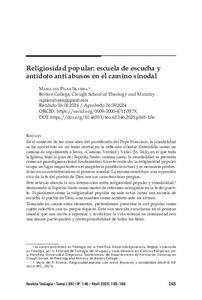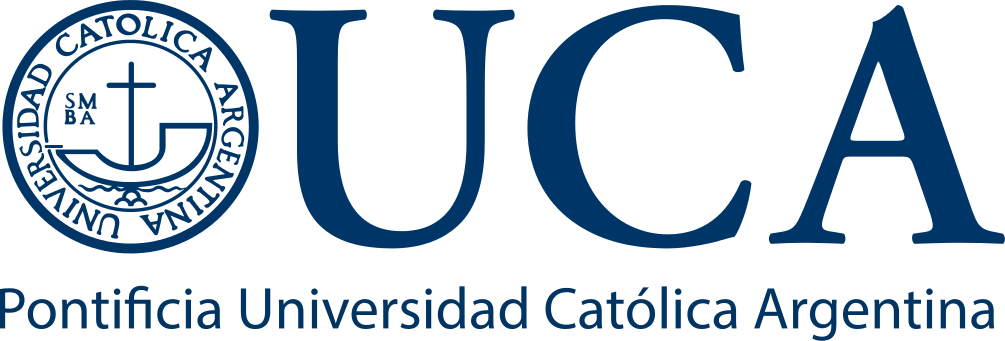Por favor, use este identificador para citar o enlazar este ítem:
https://repositorio.uca.edu.ar/handle/123456789/20136| Campo DC | Valor | Lengua/Idioma |
|---|---|---|
| dc.contributor.author | Silveira Soares de Lima, Maria del Pilar | es |
| dc.date.accessioned | 2025-07-14T21:56:19Z | - |
| dc.date.available | 2025-07-14T21:56:19Z | - |
| dc.date.issued | 2025 | - |
| dc.identifier.issn | 0328-1396 | - |
| dc.identifier.issn | 2683-7307 | - |
| dc.identifier.uri | https://repositorio.uca.edu.ar/handle/123456789/20136 | - |
| dc.description.abstract | En el contexto de los once años del pontificado del Papa Francisco, la sinodalidad se ha convertido en un tema central en la reflexión eclesial. Entendida como un camino de seguimiento a Jesús, «Camino, Verdad y Vida» (Jn. 14,6), en el que toda la Iglesia, bajo la guía del Espíritu Santo, camina junta, la sinodalidad se presenta como un paradigma eclesial fundamental. En este contexto, la religiosidad popular ocupa un lugar importante en el magisterio pontificio actual, y es necesario profundizar en su contribución en el proceso sinodal. La misma constituye una expresión viva de la fe del pueblo de Dios con sus características propias. Este artículo aborda la rica intersección entre religiosidad popular y sinodalidad,[1] destacando al Espíritu Santo como motor de reformas arraigadas en la fe del pueblo. Exploramos cómo la religiosidad popular no solo actúa como una escuela de escucha al pueblo de Dios, sino también como antídoto ante los abusos. Tomando en cuenta estos elementos, pretendemos presentar la voz popular como sujeto colectivo con su propia riqueza. Esta voz necesita escucharse en el proceso sinodal que nos invita a repensar y revitalizar la vida eclesial en comunidad con una mayor participación y corresponsabilidad de todos los fieles. | es |
| dc.description.abstract | In the context of the eleven-year pontificate of Pope Francis, synodality has be-come a central theme in ecclesial reflection. Understood as a path of discipleship following Jesus,” the Way, the Truth, and the Life” (Jon 14:6), where the entire Church, guided by the Holy Spirit, journeys together, synodality emerges as a foundational ecclesial paradigm. Within this framework, Popular Religiosity holds a significant place in the current papal magisterium, making it essential to delve deeper into its contribution to the synodal process. Popular religiosity represents a living expression of the faith of the People of God, with its distinctive characte-ristics.This article explores the rich intersection between Popular Religiosity and Synoda-lity, emphasizing the Holy Spirit as the driving force behind reforms rooted in the faith of the people. We examine how popular religiosity not only serves as a school of listening for the People of God but also acts as an antidote to abuses.Building on these elements, we aim to present the popular voice as a collective sub-ject with its own unique richness. This voice must be heard in the synodal process, which calls us to rethink and revitalize ecclesial life in the community, fostering greater participation and shared responsibility among all the faithful. | es |
| dc.format | application/pdf | es |
| dc.language.iso | spa | es |
| dc.publisher | Pontificia Universidad Católica Argentina. Facultad de Teología | es |
| dc.rights | Atribución-NoComercial-CompartirIgual 4.0 Internacional | * |
| dc.rights.uri | http://creativecommons.org/licenses/by-nc-sa/4.0/ | * |
| dc.source | Teología. Tomo 62, No. 146, 2025 | es |
| dc.subject | RELIGIOSIDAD POPULAR | es |
| dc.subject | SINODALIDAD | es |
| dc.subject | FE | es |
| dc.title | Religiosidad popular: escuela de escucha y antídoto anti abusos en el camino sinodal | es |
| dc.title | Popular religiosity: school of listening and antidote to abuses on the synodal way | es |
| dc.type | Artículo | es |
| uca.issnrd | 1 | es |
| uca.affiliation | Fil: Silveira Soares de Lima, Maria del Pilar. Boston College. Clough School of Theology and Ministry; Estados Unidos | es |
| uca.version | publishedVersion | es |
| item.languageiso639-1 | es | - |
| item.fulltext | With Fulltext | - |
| item.grantfulltext | open | - |
| Aparece en las colecciones: | TEO - 2025 Tomo LXII nro. 146 | |
Ficheros en este ítem:
| Fichero | Descripción | Tamaño | Formato | |
|---|---|---|---|---|
| Religiosidad-popular-escuela.pdf | 509,67 kB | Adobe PDF |  Visualizar/Abrir |
Este ítem está sujeto a una Licencia Creative Commons

